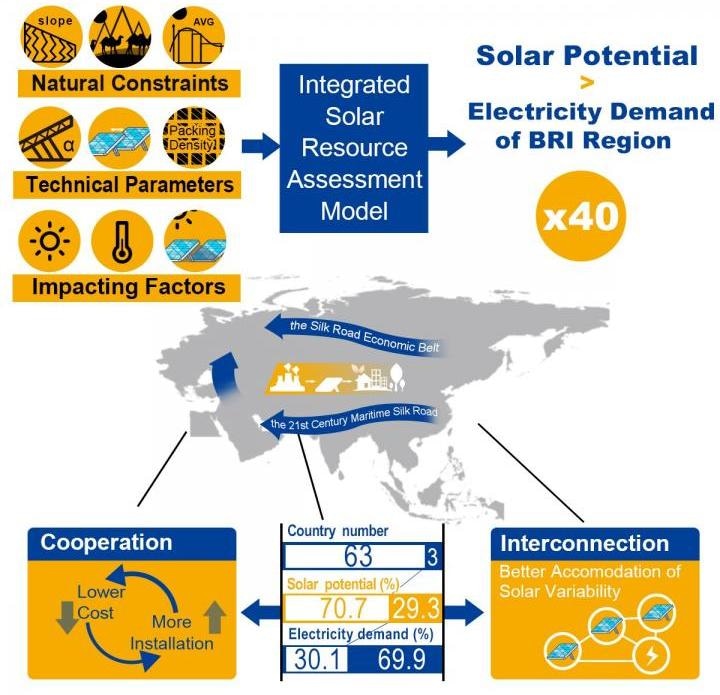Jun 28 2019
Scientists reported on June 27th, 2019 in the journal Joule that the area covered by the Belt and Road Initiative (BRI) holds considerable potential to be powered by solar energy.
 This visual abstract summarizes how with huge and imbalanced regional solar potential, cooperation and interconnection by way of the BRI offers an opportunity to decouple future economic growth from increasing carbon emissions. (Image credit: Zhan Wang)
This visual abstract summarizes how with huge and imbalanced regional solar potential, cooperation and interconnection by way of the BRI offers an opportunity to decouple future economic growth from increasing carbon emissions. (Image credit: Zhan Wang)
BRI’s electricity demand for 2030 could be met by less than 4% of the maximum solar potential of the area. The study offers a potential solution to lower the requirement of BRI countries for fossil fuels as they develop. This is the first time the renewable energy capacity of the area is measured.
The Chinese government established the BRI in 2013, with a goal to support regional development and connectivity. “Belt” stands for the Silk Road Economic Belt that echoes the ancient Silk Road, which connected Asia to Europe. “Road” represents the 21st Century Maritime Silk Road that links China to North Africa, South Asia, and South-East Asia. To date, over 120 countries in Europe, Asia, Africa, South America, North America, and Oceania are involved.
One key focus of the initiative is the construction of hard infrastructures such as buildings, railways, and power plants. However, a majority of the projects consume an enormous amount of energy, leading to high emissions. Furthermore, many countries included in the BRI are actually developing countries. In fact, there is no access to electricity for a fraction of their population. Since the region develops under the initiative, the need for power is expected to rise.
If we continue to rely on fossil fuels for energy, it can add significantly more CO2 to the atmosphere, not just this year, but for the next few decades. This is not sustainable. If we want to achieve the emission reduction goal set by the Paris Agreement, we need renewable energy.
Xi Lu, Study Co-Author, Tsinghua University
Several BRI countries, particularly those in West and South Asia, are highly exposed to sun, hence Lu and his team made a decision to evaluate the solar resource of the region. The group chose 66 BRI countries that are linked geographically and then developed an integrative spatial model to estimate their solar power potential with high-resolution data.
Firstly, the research group spotted regions ideal for constructing solar farms. These regions would get adequate solar radiation or otherwise have lower land value—regions such as agricultural land and forests are not included. After that, the researchers calculated the spacing and packing density of solar panels— which take up sunlight and produce energy—that would increase power yield for each region. Finally, they estimated the energy outputs of the regions every hour after taking restrictive factors such as shading and temperature into account, which influences the performance of solar panels.
“Our model provides a comprehensive analysis of the region’s solar energy potential by taking into account many influencing factors,” Lu stated. “We also calculated the solar energy outputs on an hourly basis, which is more accurate than previous estimates that use monthly data.”
The researchers found that these countries can produce as much as 448.9 petawatt hour of energy, which is around 41 times the demand for electricity in these countries in 2016. The 2030 electricity demand of these countries could be met by converting just 3.7% of the area’s solar energy. To realize this, it would need an investment of $11.2 trillion and a land area of 88,426 km2.
The money is very large but if you make that commitment, the energy is free. Plus, the cost of building solar farms is coming down very dramatically because of the technological advances. We project it to become similar to fossil fuels within a decade.
Michael McElroy, Study Co-Author, Harvard University
Furthermore, the analysis shows a disparity between the electricity demand and the energy potential. Countries with 70.7% of the capacity use just 30.1% of local electricity. Thus, cross-border power transmission grids can be employed to increase the advantages of solar energy by exporting excess solar electricity to satisfy the dearth in electricity supplies in other places. International cooperation is needed to implement such a project.
“It would be challenging, because different countries have different priorities when it comes to development,” Lu stated. “But the BRI is an opportunity as it sets up a framework for collaborations between countries, associations, and industries to happen. There are also funds and banks committed to promoting green development of the BRI, which provides financial support.”
Since BRI countries cover multiple time zones and different climate conditions, such cross-border grids would also aid in mitigating the consequence when sunlight is not available in some regions.
This advantage coincides with the ‘Facilities Connectivity’ concept, which is one of the five cooperation priorities of the BRI. In the context of Global Energy Interconnection (GEI), solar power generation is bound to usher in a new development opportunity in the wave of trans-national and even trans-regional power interconnection.
Shi Chen, Study First Author, Tsinghua University
“The solar potential and cooperation opportunities revealed in this analysis is a chance for the BRI countries to leapfrog from their carbon-intensive trajectories to low-carbon futures,” stated co-author Jiming Hao at Tsinghua University. “The opportunity to decouple future economic growth from increasing carbon emissions does exist.”
“Our hope here is that this paper can influence the greening of BRI, so we can try to do the initiative in a better way,” stated McElroy. “And I’m optimistic about that.”